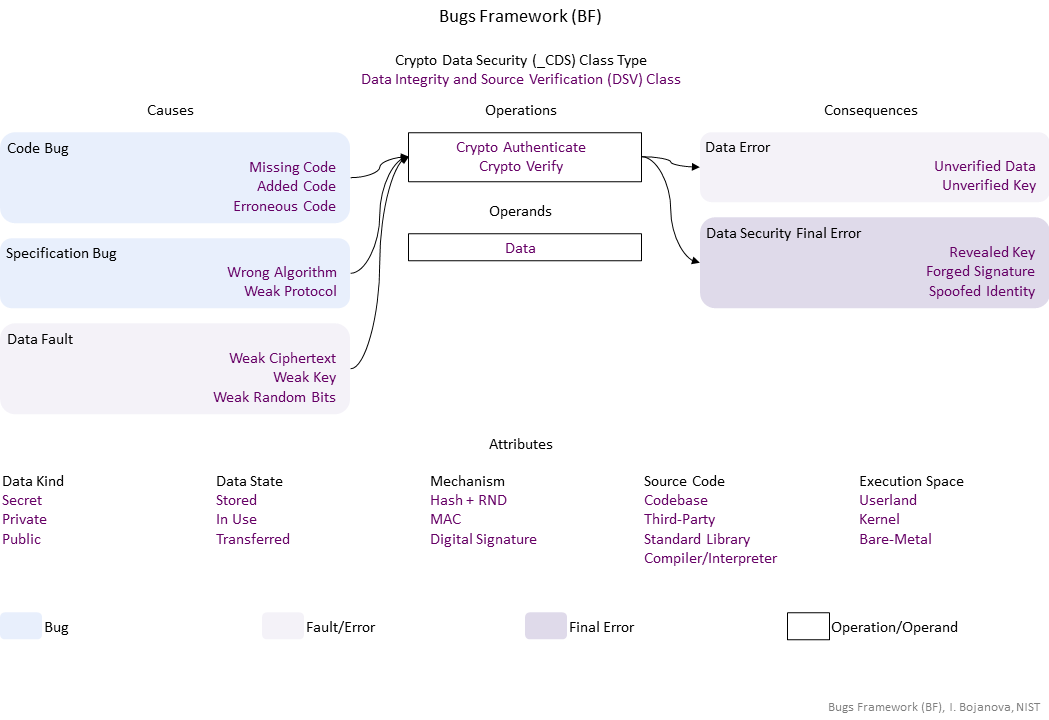| Operations | Definition |
| Crypto Authenticate | Crypto Authenticate is Sing plainttext data digitally with a source private key, or using MAC with a key. |
| Crypto Verify | Crypto Verify operation – Check signed data are not altered or prove source using source public key or MAC with a key. |
| Operands | Definition |
| Data | Data operand – The data value of an object – stored in object's memory. |
| Causes | Definition |
| Code Bug | Code Bug Type – A code operation defect – proper operands over an improper operation. A first cause for the chain of weaknesses underlying a software security vulnerability. Must be fixed to resolve the vulnerability. |
| Missing Code | |
| Added Code | |
| Erroneous Code | |
| Specification Bug | Specification Bug Type – A specification operation defect – proper operands over an improper operation. A first cause for the chain of weaknesses underlying a software security vulnerability. Must be fixed to resolve the vulnerability. |
| Wrong Algorithm | |
| Weak Protocol | |
| Data Fault | Data Fault/Error Type – The object data has harmed semantics or inconsistent or wrong value |
| Weak Ciphertext | Weak Ciphertext fault/error – yyyddd. |
| Weak Key | Weak Key fault/error – The key is of an insufficiant length. |
| Weak Random Bits | Weak Random Bits fault/error – yyyddd. |
| Consequences | Definition |
| Data Error | Data Fault/Error Type – The object data has harmed semantics or inconsistent or wrong value |
| Unverified Data | Unverified Data fault/error – yyyddd. |
| Unverified Key | Unverified Key fault/error – yyyddd. |
| Data Security Final Error | Data Security exploitable error type – xxx |
| Revealed Key | Revealed Key exploitable error – An initialization vectors (IVs) is exposed. |
| Forged Signature | |
| Spoofed Identity | Spoofed Identity exploitable error – yyyddd |
| Operations Attributes | Definition |
| Mechanism | Mechanism operation attribute type – Shows how the buggy/faulty operation code is performed. |
| Hash + RND | Hash + RND operation attribute – Hash Function + Random Numbers. |
| MAC | MAC operation attribute – Message Authentication Code. |
| Digital Signature | Digital Signature operation attribute – yyyddd. |
| Source Code | Source Code operation attribute type – Shows where the buggy/faulty operation code is in the program – in what kind of software. |
| Codebase | Codebase operation attribute – The operation is in the programmer's code - in the application itself. |
| Third-Party | Third-Party operation attribute – The operation is in a third-party software. |
| Standard Library | Standard Library operation attribute – The operation is in the standard library for a particular programming language. |
| Compiler/Interpreter | Compiler/Interpreter operation attribute – The operation is in the language processor that allows execution or creates executables (compiler, assembler, interpreter). |
| Execution Space | Execution Space operation attribute type – Shows where the buggy/faulty operation code is running or with what privilege level. |
| Userland | Userland operation attribute – The bugged code runs in an environment with privilege levels, but in unprivileged mode (e.g., ring 3 in x86 architecture). |
| Kernel | Kernel operation attribute – The bugged code runs in an environment with privilege levels with access privileged instructions (e.g., ring 0 in x86 architecture). |
| Bare-Metal | Bare-Metal operation attribute – The bugged code runs in an environment without privilege control. Usually, the program is the only software running and has total access to the hardware. |
| Operands Attributes | Definition |
| Data Kind | Data Kind operand attribute type – Shows what the data value is. |
| Secret | Secret operand attribute – Known only by its more than one owners. |
| Private | Private operand attribute – Known only by its only owner. |
| Public | Public operand attribute – Published for all the world to see. |
| Data State | Data State operand attribute type operand attribute – Shows where the data come from. |
| Stored | Stored operand attribute – The data are from a permanent storage (e.g., file, database on a storage device). |
| In Use | In Use operand attribute – The data are from a volatile storage (e.g., RAM, cache memory). |
| Transferred | Transferred operand attribute – The data are from another device via a network (e.g., connecting analog device or another computer). |
